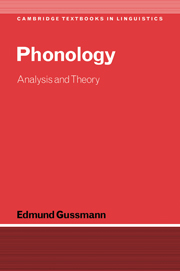Book contents
- Frontmatter
- Contents
- Preface
- List of abbreviations
- 1 Sounds and segments
- 2 The melody and the skeleton
- 3 Domains and phonological regularities
- 4 The syllable
- 5 More on codas
- 6 Some segmental regularities
- 7 Syllable structure and phonological effects: quantity in Icelandic
- 8 Segmental double agents
- 9 Words and feet: stress in Munster Irish
- Conclusion
- Appendix The phonetic alphabet of the International Phonetic Association
- References
- Index
9 - Words and feet: stress in Munster Irish
Published online by Cambridge University Press: 05 June 2012
- Frontmatter
- Contents
- Preface
- List of abbreviations
- 1 Sounds and segments
- 2 The melody and the skeleton
- 3 Domains and phonological regularities
- 4 The syllable
- 5 More on codas
- 6 Some segmental regularities
- 7 Syllable structure and phonological effects: quantity in Icelandic
- 8 Segmental double agents
- 9 Words and feet: stress in Munster Irish
- Conclusion
- Appendix The phonetic alphabet of the International Phonetic Association
- References
- Index
Summary
Introduction
One of the first problems we presented in chapter 1 was the alternation of the low vowels [α – a] in Muskerry Irish. It seems fitting that we should turn again to a dialect of Irish in the last chapter. The dialect in question is that of the southern region, also called Munster, and we will be examining some problems connected with the placement of primary stress on its basis. Our main concern is not the stress intricacies of a given group of dialects. What will primarily concern us will be the theoretical machinery required for an insightful description of one particular stress system.
The choice of Munster Irish is dictated by the fact that its stress system is not of the fixed type found in languages such as French or Finnish, where relatively little of theoretical interest could be said. Nor is it of the extremely complex kind found in English or Russian where little could be said within a single chapter. We will see that the skeletal and melodic structures organised into onsets and rhymes as syllabic constituents are not capable of handling the job of describing Munster Irish stress, and consequently the machinery will be enriched by the inclusion of feet. As throughout this book we show that such an enrichment is not just possible, which it always is, but indispensable. In what follows we study the data to find out why rhymes will not do and why feet are necessary.
- Type
- Chapter
- Information
- PhonologyAnalysis and Theory, pp. 205 - 223Publisher: Cambridge University PressPrint publication year: 2002



